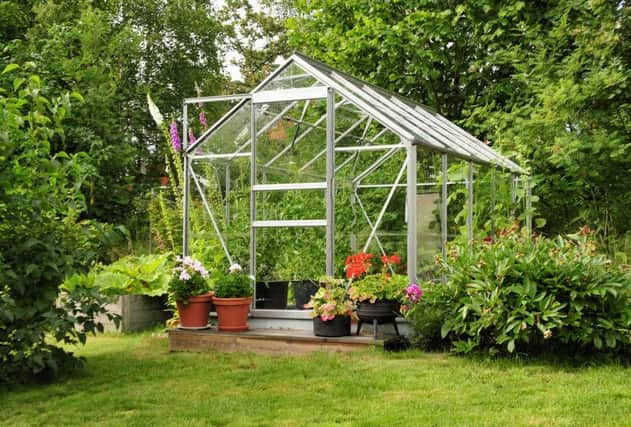Get ahead in the greenhouse


A clean greenhouse means plants will be less vulnerable to pests and diseases and, if you zap them now, your undercover growing area won’t become a breeding ground for nuisances.
Before you start, take out as much as you can and turn off the power to electric points, covering them to stop any water splashing them.
Advertisement
Hide AdAdvertisement
Hide AdThe best tools for cleaning the outside are a good hose and a long-handled soft-bristled brush for tackling the roof glass, using a large sponge. Give it a good rub to remove algae and, if panes overlap, use an old plant label to ease out the dirt and then rinse the area with a hose. Replace cracked or broken panes or get a professional to do it if you don’t feel confident.


Clear greenhouse gutters, removing soggy leaves and debris which could end up in water butts or block your drains. Get a long-handled brush to get rid of the rubbish before it enters the downpipes.
Once the greenhouse is empty, give the floor a really good sweep and get rid of clutter like broken pots, out-of-date feeds and other junk.
Wipe down surfaces with a scouring sponge and wash flower pots and seed trays with disinfectant before thoroughly rinsing and returning to their place in the greenhouse.
Advertisement
Hide AdAdvertisement
Hide AdHorticulturist Frances Tophill, co-presenter of ITV’s Love Your Garden and guest speaker at the forthcoming Edible Garden Show in Warwickshire, says: “The art of a good greenhouse is to have a more or less constant temperature.


“In the winter, a heater might be required or a little bubble wrap on the glass. Plants will suffer most if their foliage is in direct contact with the cold glass, so move them away during the winter months.”
The warmth provided in a greenhouse will help a multitude of insects to overwinter in the warm and come back with gusto in the spring to attack your plants.
“To avoid that happening, give your greenhouse a big winter clean-up, paying particular attention to any standing water where larvae may well be multiplying.”
Advertisement
Hide AdAdvertisement
Hide AdNow is the time to think about growing your early vegetables.
“Early carrots and parsnips (make sure you use one that is canker resistant) are ideal to start in February,” says Tophill. “It’s also a great time to start your garlic and small onions or shallots. If you have the luxury of a greenhouse then now is the time for growing all your tomatoes, peppers and aubergines.
“Also grow radishes, brassicas and all your peas, including late sweet peas. Now is also the time to get that summer bedding going. So start sowing cleome, dahlias, ricinus (castor oil plant), snapdragons and cerinthe.”
Many plants just need the protection of a frost-free environment to germinate, so can be grown in a non-heated greenhouse or in a cold frame.
Advertisement
Hide AdAdvertisement
Hide Ad“Some seeds actually need a period of intense cold known as stratification before they will germinate. So it is all a matter of looking at your seeds, reading the packets carefully and treating them accordingly.
“If you only have a non-heated greenhouse, I always find a windowsill in the kitchen works a treat!”
The Edible Garden Show, Stoneleigh Park, Warwickshire, runs from March 11-13. Visit www.theediblegardenshow.co.uk